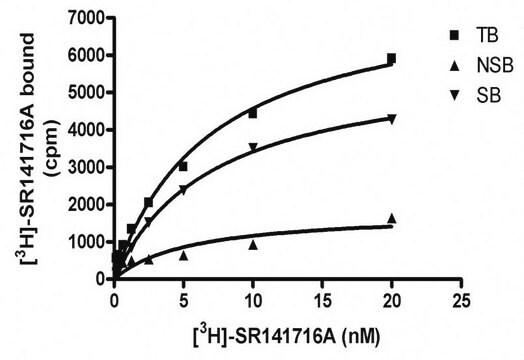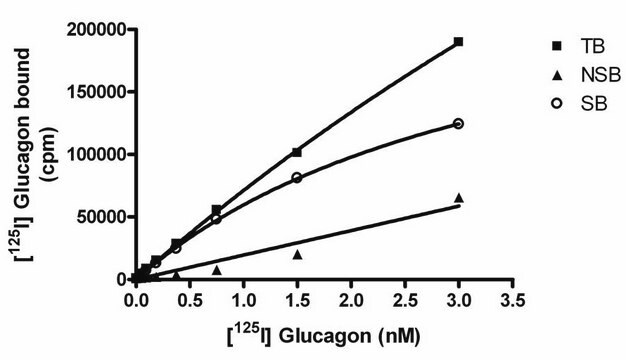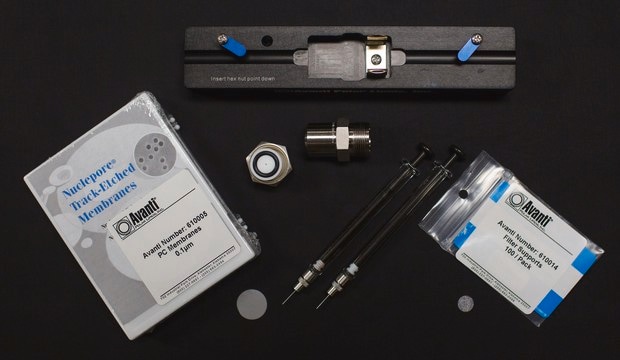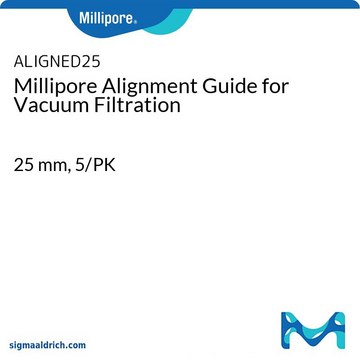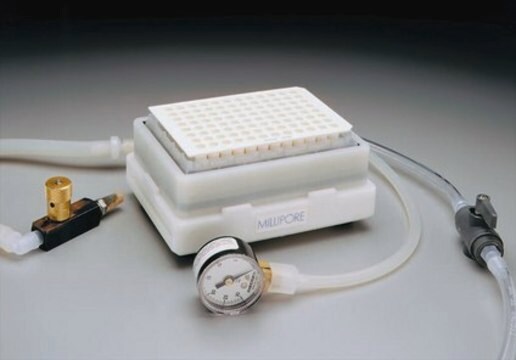HTS101M
CHEMISCREEN MEMBRANE PREPARATION RECOMBINANT HUMAN µ (Mu) OPIOID RECEPTOR
Human Mu / OP3 / MOP / MOR GPCR membrane preparation for GTPγS Binding & Radioligand Binding Assays.
Synonim(y):
Przygotowanie błony receptora µ-Opioidowego, Zestaw receptorów ChemiSCREEN
About This Item
Polecane produkty
pochodzenie biologiczne
human
Poziom jakości
rekombinowane
expressed in Chem-5 cells
producent / nazwa handlowa
ChemiScreen
Chemicon®
metody
ligand binding assay: suitable (GTPγS)
radioligand binding assay (RLBA): suitable
numer dostępu NCBI
numer dostępu UniProt
Warunki transportu
dry ice
informacje o genach
human ... OPRM1(4988)
Opis ogólny
Zastosowanie
Działania biochem./fizjol.
Jakość
Charakterystyka techniczna
WARUNKI ASSAY: Membrany są permeabilizowane przez dodanie saponiny do równego stężenia masowego, a następnie mieszane z[35S]-GTPγS (końcowe stężenie 0,3 nM) w 20 mM HEPES, pH 7,4/100 mM NaCl/10 mM MgCl2/0,5 μM GDP w niewiążącej 96-dołkowej płytce. Nieznakowane DAMGO dodano do końcowego stężenia wskazanego na rysunku 1 (końcowa objętość 100 μL) i inkubowano przez 30 minut w temperaturze 30°C. Reakcja wiązania jest przenoszona na płytkę z filtrem FB (Millipore MAHF B1H) uprzednio zwilżoną wodą i płukana 3 razy (1 ml na studzienkę na płukanie) zimnym 10 mM fosforanem sodu, pH 7,4. Płytka jest suszona i liczona.
Jedna fiolka zawiera wystarczającą ilość membran na co najmniej 200 testów (jednostek), gdzie jedna jednostka to ilość membrany, która da więcej niż 1000 cpm specyficznego wiązania[35S]-GTPγS stymulowanego przez DAMGO.
Oczekuje się, że preparat błonowy receptora opioidowego μ będzie funkcjonalny w teście wiązania radioligandu; jednak użytkownik końcowy będzie musiał określić optymalny ligand znakowany radioligandem do stosowania z tym produktem.
Postać fizyczna
Metoda pakowania: Białko błonowe dostosowano do wskazanego stężenia w buforze do pakowania, szybko zamrożono i przechowywano w temperaturze -80°C
Przechowywanie i stabilność
Informacje prawne
Oświadczenie o zrzeczeniu się odpowiedzialności
Kod klasy składowania
12 - Non Combustible Liquids
Klasa zagrożenia wodnego (WGK)
WGK 2
Certyfikaty analizy (CoA)
Poszukaj Certyfikaty analizy (CoA), wpisując numer partii/serii produktów. Numery serii i partii można znaleźć na etykiecie produktu po słowach „seria” lub „partia”.
Masz już ten produkt?
Dokumenty związane z niedawno zakupionymi produktami zostały zamieszczone w Bibliotece dokumentów.
Nasz zespół naukowców ma doświadczenie we wszystkich obszarach badań, w tym w naukach przyrodniczych, materiałoznawstwie, syntezie chemicznej, chromatografii, analityce i wielu innych dziedzinach.
Skontaktuj się z zespołem ds. pomocy technicznej